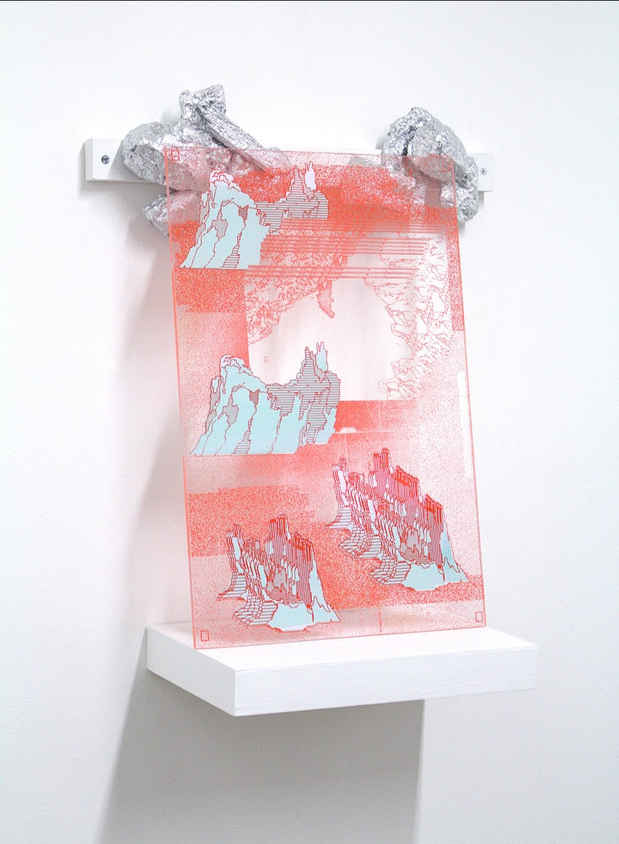Naomi Nakazato and Brian Zegeer “Roadside Picnic”
Field Projects

This event has ended.
Curated by Rachel Frank
“A picnic. Imagine: a forest, a country road, a meadow. A car pulls off the road into the meadow and unloads young men, bottles, picnic baskets, girls, transistor radios, cameras … A fire is lit, tents are pitched, music is played. And in the morning they leave. The animals, birds, and insects that were watching the whole night in horror crawl out of their shelters. And what do they see? An oil spill, a gasoline puddle, old spark plugs and oil filters strewn about … Scattered rags, burnt-out bulbs, someone has dropped a monkey wrench. The wheels have tracked mud from some godforsaken swamp … and, of course, there are the remains of the campfire, apple cores, candy wrappers, tins, bottles, someone’s handkerchief, someone’s penknife, old ragged newspapers, coins, wilted flowers from another meadow …”
-Roadside Picnic, Arkady and Boris Strugatsky
Roadside Picnic by Soviet-Russian authors Arkady and Boris Strugatsky was published in 1972. Stalker, the film by Andrei Tarkovsky, which was based loosely on the novel, came out in 1979.
In Roadside Picnic, an event: an unseen meteorite or alien visitation has created an off-limits area on Earth called the Zone. This area is littered with enigmatic artifacts left over from the event, which hold both great technological power and immense danger. The true purpose of these objects is unknown to the scientists who study them and to the Stalkers who risk their lives to collect them for money. The landscape within the Zone appears normal, but has been transformed by the event. Flowers hold no scent, common things like cobwebs and grass may not be what they seem, time moves at another pace, and there are hidden dangers if one does not properly read the landscape and move with care. People too are transformed by the Zone and sometimes never return. Because of these dangers, the Zone is abandoned and forbidden, but like anything that is prohibited and unknown, this intensifies the desires and the myths about the landscape.
Naomi Nakazato examines her divergent biracial Japanese-American identity and questions of authenticity and belonging through a mixture of printmaking, sculpture, and use of mass-produced industrial materials. Pulling from online stock photos of landscapes –idealized but inaccessible versions of place– Nakazato combines topographical elements with fragments of language amid fields of technological grids. The landscape elements are printed on transparent Plexiglas allowing these topographies to be multiplied and imposed over the space of the gallery like a form of low- tech virtual reality. The addition of handmade marks serves to humanize these synthetic elements adding glitches to the technological field. By presenting the works either lower to the viewer or on slightly raised platforms, these fragments of place are further idealized and ritualized as places of desire.
Brian Zegeer’s work uses landscape elements, the body, and sculptural collage to explore the impacts of genetics, biology, and place on identity and familial relationships. Advances in medical science and companies like 23andMe allow us to have intimate knowledge about the various hidden diseases, susceptibilities, and risks to our health (while also sharing this lucrative data) based on our DNA. At the same time we are learning how the trillions of microorganisms living within our bodies affect our health, mental well being, weight, and other factors. These hidden internal genetic markers and bacterial ecosystems coupled with the daily environmental factors we are exposed to are imposing influence on our bodies, manifesting themselves in various ways. The competition and influence of these entities on the self lead to questions of agency and responsibility. In Zegeer’s tangled collages, the distinction between the man-made, the body, and the natural landscape dissolve and become hybrid forms anxiously impressing upon one another.
Naomi Nakazato’s (b. 1992 Arlington, VA) multidisciplinary work spans drawing, painting, sculpture, printmaking, and installation to examine belonging and location within hybridity. She received a BA from Anderson University, South Carolina and an MFA from The New York Academy of Art, New York. Nakazato was awarded two Elizabeth Greenshields Foundation Grants, an initiate Brandon Fellowship at the Greenville Center for the Creative Arts in Greenville, South Carolina, a 2017 summer residency at the Leipzig International Artists Program in Leipzig, Germany, and a Keyholder Residency at The Lower East Side Printshop. She lives and works in Brooklyn, NY.
Brian Zegeer was born in Lexington, Kentucky. His works encounter the Appalachian and Lebanese landscapes of his upbringing as highly-charged networks of belonging and collective hallucination. Interventions into the visual archives, and stop-motion animations conducted in-the- field, are meant to challenge conventional narratives and enter into a more speculative relationship to history. Zegeer received an MFA from the University of Pennsylvania, attended Skowhegan School of Sculpture and Painting in 2010, and has recently shown at The Queens Museum, The Bronx Museum of Art, The Delaware Art Museum, The Jersey City Museum, Tiger Strikes Asteroid, Danese/Corey Gallery, and The Elizabeth Foundation for the Arts.
Media
Schedule
from February 20, 2020 to April 04, 2020
Opening Reception on 2020-02-20 from 18:00 to 20:00